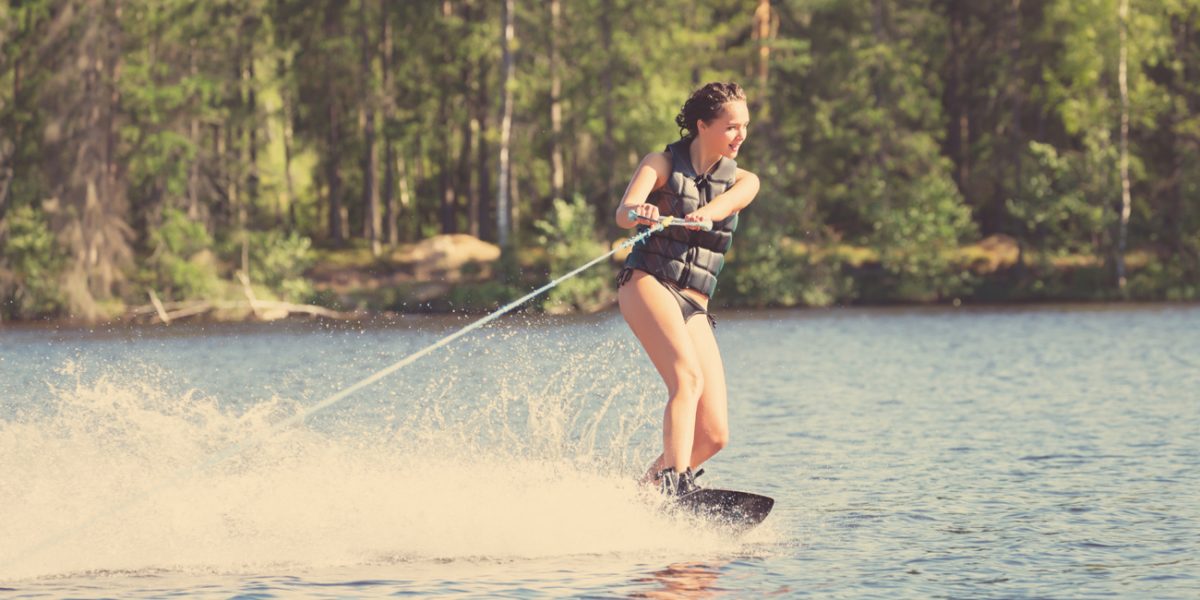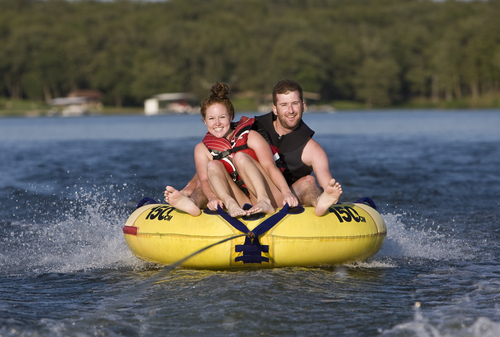
The Water’s Calling…
…and now more than ever—with COVID-19 keeping us (mostly) indoors—folks are eager to answer the call.
There is no better way to get outside, stretch our legs, and remain socially distanced than on a boat or lake. There are a multitude of activities to participate in, from wakeboarding and waterskiing to water tubing and boating.
While these activities may be providing us with some much needed exercise, fun, and enjoyment, they do come with their fair share of risks for injury.
Before heading out on the water, educate yourself on common lake and boating injuries and arm yourself with important prevention techniques.
Common Lake and Boating Injuries
There are different risks associated with the various lake and boating activities one can participate in:
Wakeboarding and Water Skiing
Wakeboarding involves a person on a wakeboard (think snowboard) holding onto a handle attached to a rope while being pulled by a boat. Water skiing is the same concept, except that water skis (think snow skis) are used. Both sports typically involve the performance of aggressive stunts at high speeds, which means that the risk for injury is fairly high.
Since they are similar sports, wakeboarding and water skiing carry risk for a similar set of injuries:
- Anterior Cruciate Ligament (ACL) Tears
A tear to the ACL, which is one of four ligaments in the knee joint that hold the bones together and provide stability.
- Shoulder Dislocations
When the head of the upper arm bone (humerus) is either partially or fully out of the socket (glenoid).
- Ankle Sprains
When the ligaments of the ankle stretch or tear.
- Lacerations
Jagged tears of the skin that commonly occur on the head and face, especially in the case of wakeboarding.
Water Tubing
Water tubing may appear to be less risky when compared to wakeboarding and water skiing, but a recent study has concluded just the opposite.
The Center for Injury Research and Policy of The Research Institute at Nationwide Children’s Hospital found that water tubing injuries have increased 250% over the study’s 19-year period. They attribute this startling increase to a participant’s position on the water tube, the number of people that sit on a tube together, and the lack of directional and velocity control.
The study found that the head is the most commonly injured body part, with the arms (upper extremities) following as a close second. Almost half of all injuries occur due to impact with the water, while another 16% are due to collision with another rider.
 Sprain, strains, and soft tissue injuries account for almost half of all water tubing injuries. Soft tissue injuries are injuries to the muscles, tendons, and ligaments. Sprains are a stretch and/or tear of a ligament (the strong band of connective tissue that connects one end of a bone to another). Strains are the same as sprains except they affect tendons, which link muscles to bones.
Sprain, strains, and soft tissue injuries account for almost half of all water tubing injuries. Soft tissue injuries are injuries to the muscles, tendons, and ligaments. Sprains are a stretch and/or tear of a ligament (the strong band of connective tissue that connects one end of a bone to another). Strains are the same as sprains except they affect tendons, which link muscles to bones.
Recreational Boating
Staying put inside a boat sounds like a pretty safe bet, but it actually has been found to cause some of the most severe injuries of all lake and boating activities.
The U.S. Coast Guard reported that over 2,600 injuries occurred in 2017 alone, due to recreational boating accidents.
These accidents typically occur in one of three ways: a person falls overboard, the boat capsizes, or the boat collides with another object or boat. These can result in serious injuries, including:
- Spinal Cord Injuries
Damage to the spinal cord or nerves at the end of the spinal canal.
- Burns
Tissue damage that causes the affected skin cells to die, and can vary in size and severity.
- Fractures
Broken bones that can be open (bones protruding out of skin) or closed (breaks contained within the skin).
- Accidental Amputations
Partial or complete detachment of a body part.
Prevention Tips for Common Lake and Boating Injuries
Sometimes, injuries are out of our control; but more often than not, injuries can be prevented when proper precautions and prevention techniques are practiced:
When water tubing…
- Wear a personal flotation device and other recommended safety equipment.
- Follow your tube’s safety guidelines and recommendations, paying close attention to the maximum number of people and weight per tube.
- Inspect all equipment, including the tube, boat, and rope, before riding.
- Exercise extra caution when riding with other people.
- Be aware of your surroundings.
- Select a boat driver you trust.
When wakeboarding or water skiing…
- Wear protective gear to decrease the chance of lacerations.
- Choose a tow rope with a plastic and/or foam coating.
- Ensure the foot bindings are made of strong, high-quality materials that properly support your ankles.
- Do not wakeboard or water ski at night or in other hazardous weather conditions where your sight is impaired and you cannot spot hazards.
When recreationally boating…
- Exercise UV-protection via sunscreen, sunglasses, a hat, and SPF lip balm.
- Wear a life jacket and other necessary safety equipment
- Practice propeller safety and do not let anyone enter or exit the boat while the engine is on.
- Count all passengers before leaving the dock and make sure everyone is accounted for at the end.
- Do not consume alcohol and boat, especially if you are the driver.
- Take a boating safety course.
- Be aware of and follow all state boating laws.
- Do not boat in inclement weather.
Keep in mind that most of the above safety tips are applicable to all maritime sports and activities.
Enjoy Your Summer With EmergeOrtho—Triangle Region
The Sports Medicine Specialists at EmergeOrtho—Triangle Region are experts on common lake and boating injuries and how to best prevent them. Based on our years of practice and education, our board-certified, fellowship-trained team can offer expert knowledge of maritime injuries, treatments, and prevention techniques.
Although we hope you feel better prepared to avoid any lake and boating injuries, if an injury does occur, know we will be standing by ready to help you make a swift recovery!
To learn more, self-schedule an appointment now. Or, call us any time at (919) 220-5255.







